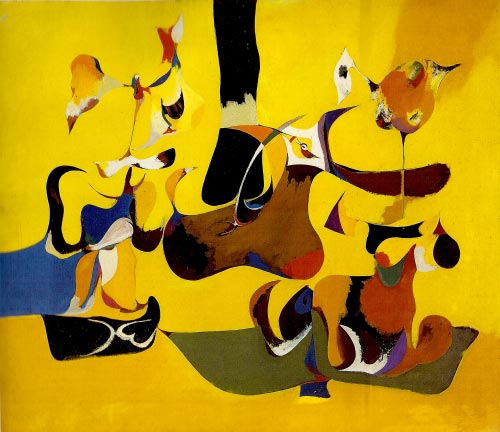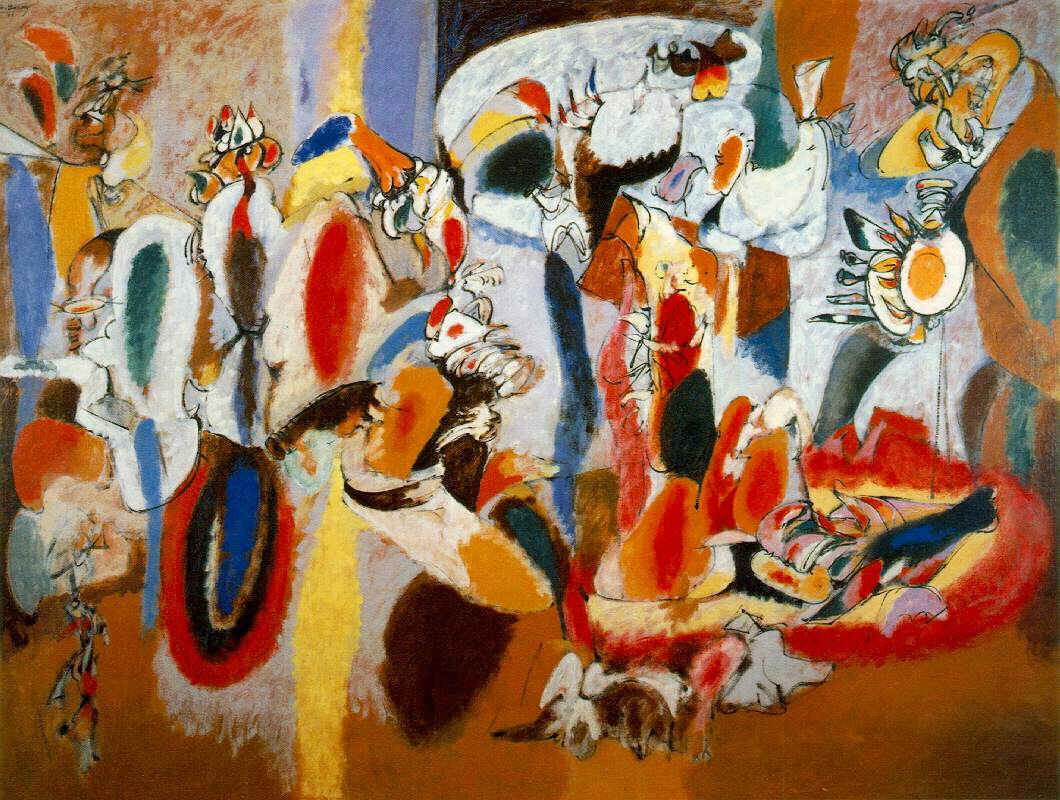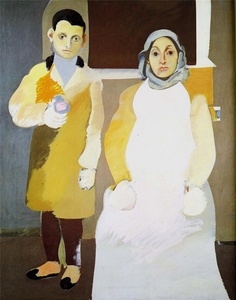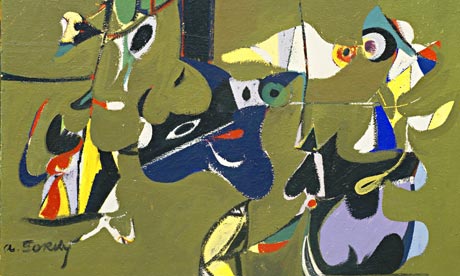Arshile Gorky Garden In Sochi
 "Garden in Sochi," Arshile Gorky, oil, 1940- 41. Courtesy studiointernational.com
"Garden in Sochi," Arshile Gorky, oil, 1940- 41. Courtesy studiointernational.com
When I showtime heard that the winter Olympics would be held in Sochi, I thought information technology must be a beautiful identify, endowed with sumptuous Russian landscapes. That's because my primary clan with the metropolis is a series of paintings that Arshile Gorky (built-in, Vosdanig Adoian) created in 1940 through 1943, titled Garden in Sochi. And then I nowadays several digital reproductions of them with commentary inspired non only past these wonderful paintings but by two aspects of the Olympics that take grabbed me.
The first result was the operation at the Cultural Olympiad in Sochi by the Brian Lynch Quartet, led by the Grammy-winning, Milwaukee-raised trumpeter who has worked in the bands of many jazz greats including Art Blakey and the Jazz Messengers, Horace Silvery, Toshiko Akiyoshi, Phil Woods, and Eddie Palmieri. I recently wrote at length about Lynch's recent recordings on another Culture Currents posting. But he played a time-honored role as an American cultural administrator and he's a product of both Nicolet High School and the Wisconsin Conservatory of Music, and the surprisingly vibrant jazz scene of Milwaukee in the late 1970s and early on 1980's.
I'chiliad also jubilant the first gold medal ever won past America in water ice dancing, thanks to the dazzlingly executed and sublime performance of Meryl Davis and Charlie White, a duet functioning that few artistic athletes could equal, a testament to youthful dedication and vision.
So my field of study is fine art and its resonances and, if they had asked me, the Cultural Olympiad would have borrowed one of Gorky's Sochi paintings and used information technology equally a motif in their promotional efforts for the Olympics. These cute works are both evocative of the region'south natural splendor while being distinctly modern in their abstract and dynamic lyricism. I now see certain athletic postures and gestures in these forms.
In the painting above, come across the figure in the upper left, seemingly balancing on 1 leg and holding other limbs and bodily forms out in a complex and exuberant manner. Throughout the composition, the undulating forms can be seen as expanding and contracting muscles and tendons amid exertion and artful self command. Gorky surely never consciously intended such associations, but they seem valid now, because this is an art of allusion.
"By allusion the thing alluded to is both there and non there," the critic Harold Rosenberg wrote of Gorky's abstract work. "Innuendo is the footing upon which painting could, step-past-step, dispense with delineation, without loss of meaning." Thus, I contend the meaning could become multi-various, similar the forms that arise in a garden each spring, related to forebears, yet each possessing unique character.
Allusion's regenerative significant was accomplished through "emotional reference, evoked by color, shape, by motility…" Rosenberg wrote, which brings us back to concrete art of motion, like ice dancing.i
Rosenberg and a number of other observers too come across the weight of history in Gorky'southward piece of work, as did the artist himself. His fine art testifies to the plight of the nearly perennially oppressed Armenian people, an experience that many ethnic cultures of the sprawling regions of greater Russia endured too, through that nation's troubled, tragic and powerfully human history.
As a teenager, Gorky tried to flee with his mother and his sis Vartoosh to escape the Turkish genocide of Armenia. These children and Lady Shushanik were forced on the 100-mile "decease march" of 1915 to the borderland of Caucasian Armenia. The mother grew sick as she refused nearly food and water that her children aimlessly searched for, because she cared about their health and welfare over her own. According to Vartoosh's son Karlen Mooradian, "In a frenzied endeavour to obtain nutrient coin, Gorky, aided by Vartoosh, carved traditional Armenian women's combs from ox and bull antlers acquired from street vendors, and tried to sell them." two This feel may be a genesis of one of his most famous paintings,The Liver is the Cock's Rummage which, though a afterwards and more than complex piece of work, actually contains compositional parallels to the Garden in Sochi series.  "The Liver is the Cock's Comb," Arshile Gorky 1944: Courtesy wiki paintings.com
"The Liver is the Cock's Comb," Arshile Gorky 1944: Courtesy wiki paintings.com
The Adoian family had hoped to accomplish the Georgian upper-case letter, about 100 miles to the north and toward Sochi. But they never got across Yerevan, considering the mother became critically ill from malnutrition and refused to leave the soil of Armenia.
Subsequently the government refused to permit the children to identify their mother in a infirmary for homeless genocide orphans, the brother and sis tried to intendance for her in an old "state of war-torn room in a dusty abandoned construction whose inhabitants had been killed," wrote Mooradian. The roof leaked when the snowfall began melting nearly the end of the winter of 1919, and each morning before leaving, Arshile and Vartoosh "lifted upwardly their mother and placed her on the window ledge to lessen the chance of forgetting wet."
On March 20th of that bound, 39-year-old Lady Shushanik complanate in the arms of her children — dead of starvation and of the genocide that killed two 1000000 Armenians, or iii-quarters of the nation. The Turks were too warring with Russian federation, so Armenia became a great battlefield. At the time, Vartoosh was 13 and Gorky was nearly 15, and offset to develop strong creative sensibilities. three
Vartoosh says that his mother taught her brother "the poetry of Van'southward nature. Of the sea, plants, animals, the mountains and valleys, the world and clouds. She was the port Queen. Gorky never forgot what she had taught him.' Someday,' he told me, 'my paintings of mother will make her live forever."4  "Portrait of the Creative person with his Female parent," Arshile Gorky, 1926-29, Whitney Museum of American Art. Courtesy pinterest.com
"Portrait of the Creative person with his Female parent," Arshile Gorky, 1926-29, Whitney Museum of American Art. Courtesy pinterest.com
And a couple of paintings and drawings of their cute mother are among Gorky's about famous works of art and show his mastery of traditional and modernist artistic portraiture. Gorky wrote in a 1943 letter that he should take really titled the Sochi serial Garden in Khorkom, for a Gorky family garden in Armenia. Nevertheless, one can imagine that he envisioned this garden in Sochi equally signifying the family unit's deliverance — Sochi was the closest urban center in Russia that would not exist nether Turkish influence. In the letter of the alphabet, he referred to the family garden, perhaps to gratify family unit members: "In that series I have, for example, depicted most prominently the beautiful Armenian slippers male parent and I used to vesture, the ones we purchased in Armenia'south Van from the Armenian artists when uncle Grikor and I rode there by horse."
 Some other variation in Arshile Gorky'due south "Garden in Sochi" series from 1943 nowritza.pwp.bluyonder.co.uk
Some other variation in Arshile Gorky'due south "Garden in Sochi" series from 1943 nowritza.pwp.bluyonder.co.uk
The artist likewise depicts "my translations of mother's soft Armenian butter churn, that pearl in the crown of our hard-working hamlet women. How vividly those days imprint themselves in my heart." (Annotation: There is controversy over some of the Gorky letters published by the late Mooradian, whom some art scholars accuse of forging or irresolute some of his uncle'south messages.)5
This evocation as well reveals Gorky's deep analogousness for Armenia's ancient and widely influential culture, what Mooradian extensively argued is Gorky's predominant "hylozoist" outlook. One tin can begin to sense the dark and deeply personal historical complexities of expression in Gorky's inherently lyrical abstractions.
Rosenberg saw Gorky'due south equally work as less biographical while acknowledging their historical heft. Gorky was an extremely erudite amateur historian of fine art and his early piece of work clearly claimed Picasso and Cézanne equally influences. Joan Miro'south influence is also evident underlying some of the Armenian creative person's fanciful forms and compositions.
Gorky'due south went on to get amongst the greatest of the first generation of American abstract expressionists, which included many immigrants who fled war-ravaged Europe, Russia and the Middle East. Willem de Kooning, who once shared a studio with Gorky, commented: "He knew lots more well-nigh painting and art—he but knew information technology by nature—things I was supposed to know and feel and understand. . . . He had an extraordinary gift for hitting the nail on the head." half-dozen
So, given Arshile Gorky's sense of fine art'southward historical threads of evolution, Rosenberg saw the abstract art as products of a program "experimental research." : "Each of the unlike versions garden in Sochi is a rap upon a different stylistic door to the future, and a disappointed turning away when no answer comes.
"We can see today that the 1940s Garden was a sufficient opening through which unexplored regions might take been reached. Unfortunately, history, when information technology does supply answers, never labels them as such." 7
So the Sochi paintings' echoes of creative allusion resonate with the night clouds of historical experience, and even so remain alive with the inspiring energy of springtime — and of dogged human achievement.
To brand them a world customs feel, pan-cultural events like the Olympics demand all the historical resonance they can get.
 A third "Garden in Sochi," variation past Gorky, from the Museum of Mod Art. courtesy the Guardian.com
A third "Garden in Sochi," variation past Gorky, from the Museum of Mod Art. courtesy the Guardian.com
____________________________
1. Harold Rosenberg,Arshile Gorky: the Man, the Fourth dimension, the Idea, , Horizon, 1962, 55-56
iiKarlen Mooradian,Arshile Gorky Adoian, , Gilgamesh, 1978,143
iii. Ibid. 147-48
4. Ibid. 148
5. Ibid. 277 (NOTE: Arshile Gorky Adoian and sister Vartoosh escaped to America in 1920, a story recounted in a previous Civilization Currents posting https://kevernacular.com/?p=1848 which further details Gorky'southward artistic evolution and human relationship to his female parent, and my visit with Vartoosh Adoian Mooradian and Karlen Mooradian. I was fortunate to meet them in Chicago, after they noticed a review I wrote of the 1981 Gorky retrospective at the Guggenheim Museum.
6. Melissa Kerr, Gorky Life Chronology, The Arshile Gorky Foundationhttp://arshilegorkyfoundation.org/gorkys-life/chronology
seven. Rosenberg, 82-83.
Arshile Gorky Garden In Sochi,
Source: https://kevernacular.com/?p=2996
Posted by: romerohipen1945.blogspot.com



0 Response to "Arshile Gorky Garden In Sochi"
Post a Comment